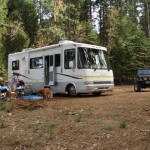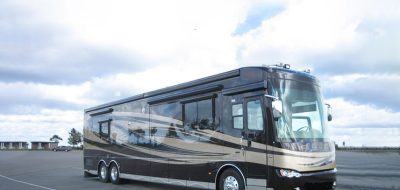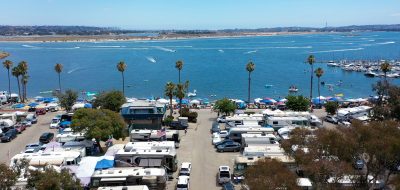For almost as long as there have been automobiles, recreational vehicles have been traversing America’s roads. The history of RVing starts in the early 20th Century. In 1910, there were few gas stations, few paved roads, and no highway system. But there were RVs. 1910 is the year that America’s leading RV historians cite as the beginning of what has become the modern RV industry. The first RV was Pierce-Arrow’s Touring Landau, which debuted at Madison Square Garden in 1910. Camping trailers made by Los Angeles Trailer Works and Auto-Kamp Trailers also rolled off the assembly line beginning in 1910.

The RV/MH Hall of Fame in Elkhart, Indiana, showcases the growth, history, and accomplishments of the recreational vehicle and manufactured housing industries, with displays and restored units dating back to 1913. © Rex Vogel, all rights reserved
The crash of 1929 and the Great Depression dampened the popularity of RVs, although some people used travel trailers, which could be purchased for $500 to $1,000, as inexpensive homes.
Streamline designs utilizing aircraft-style construction first captured the American imagination in the 1930s,. Smooth, continuous, shiny aluminum skins were found to increase efficient movement.
At that time a series of sleek, aluminum aerodynamic travel trailers designed by American entrepreneurs made their way to the marketplace. Bowlus Road Chief, Airstream, Streamline, Silver Streak, Avion, Spartan, and Plymouth House Car are but a few. The only manufacturer to survive the economic conditions of the time was Airstream.
Rationing during World War II stopped production of RVs for consumer use, although some companies converted to wartime manufacturing, making units that served as mobile hospitals and prisoner transports. After the war, the RV industry flourished as more Americans sought mobility. The burgeoning interstate highway system offered a way to go farther faster and that combination spurred a second RV boom that lasted through the 1960s.
Built between 1941 and 2004, Shasta travel trailers were originally constructed as housing for the United States Armed Forces. One of their identifying features is the “wings,” which are located on the rear sides of the trailer. It’s easy to forget the connection of wars with the history of RVing.
Motorized RVs started to become popular in the late 1950s, but they were expensive luxury items that were far less popular than trailers. That changed in 1967 when Winnebago began mass-producing what it advertised as “America’s first family of motor homes,” five models from 16 to 27 feet long, which sold for as little as $5,000.
The manufacturer’s names echo through the decades. They catch your attention when you see them on the road. Names that have vanished in the past―or stayed around because of their legendary design―these RVs of the 1940s, 50s, and 60s mark a different era.







Newby Fun Resorts
It's amazing to think that RVs used to sell for as little as $5,000. It has grown into such an expansive and exciting industry. It looks like it will just keep growing, too! More and more families are getting into the RV lifestyle.
William L. Hanson
I forgot to add that I am back to a slide in truck camper. I am alone and this is all I need. Bought it in 2005, along with my truck a Dodge 2500 Diesel.
Teresa J Breuer
What about covered wagons? They were RVs too.
William L. Hanson
I started camping with 9.5ft slide in truck camper in 1973. Cost about $1800. 2 years later bought a Wilderness 20.5ft trailer. In the west(Wyoming) the winds are very hard on travel trailers.